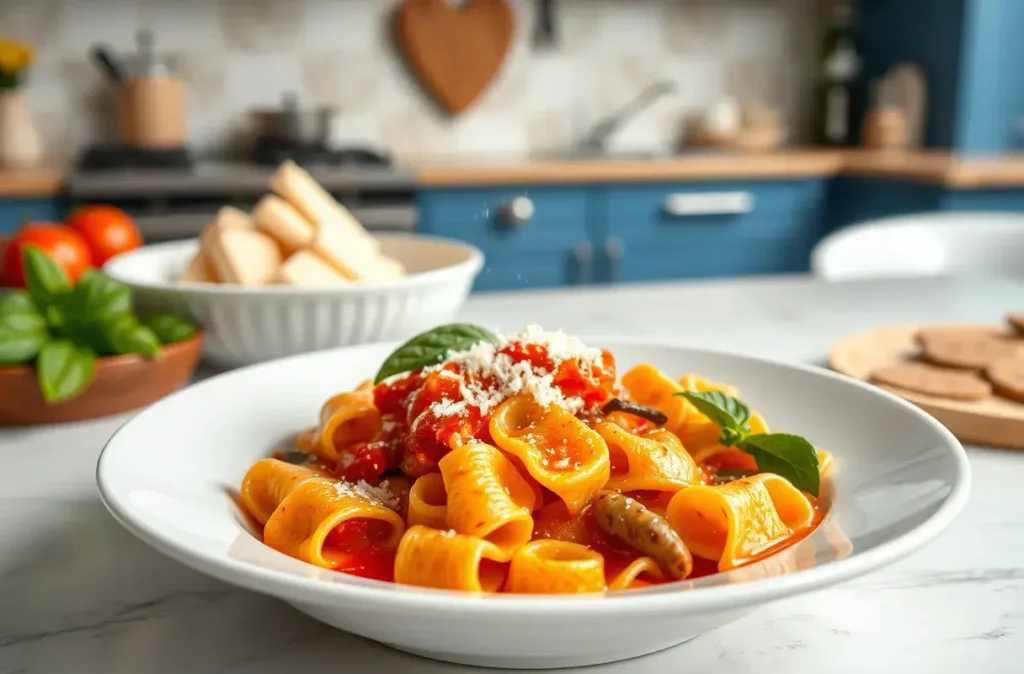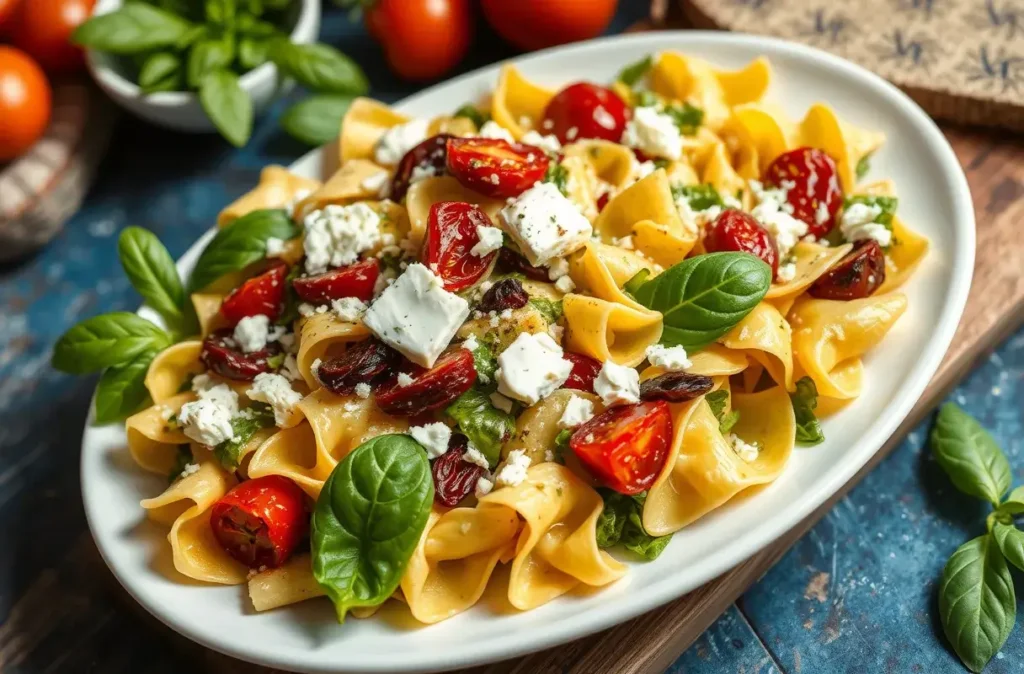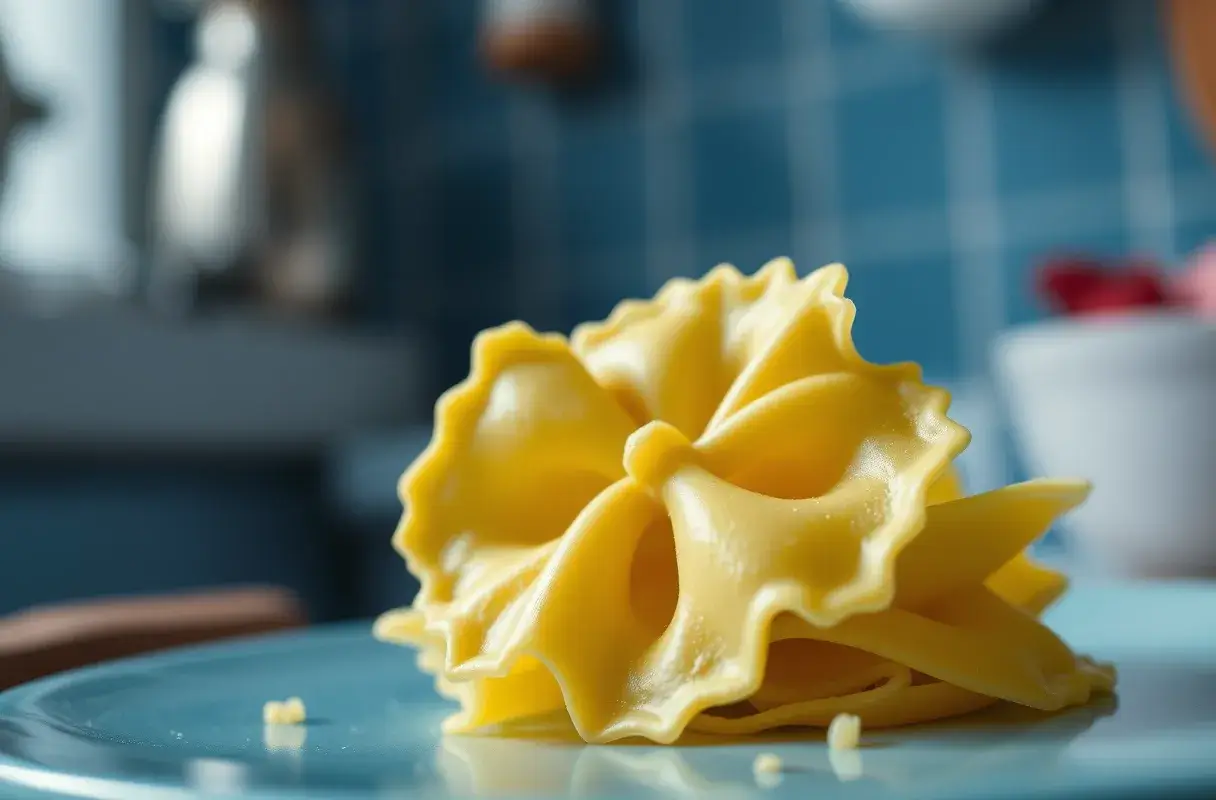Introduction: What Do Italians Use Farfalle For?
What do Italians use farfalle for? This question often intrigues pasta enthusiasts worldwide. Farfalle, frequently recognized in English as “bow-tie pasta,” holds a special place in Italian cuisine. Its distinctive shape—a pinched center with gently curved sides—makes it perfect for countless dishes, from hearty entrees to refreshing salads. In this article, we will explore the many versatile uses of farfalle in both traditional and modern Italian cooking, ensuring you have plenty of inspiration for your next culinary adventure.
How Farfalle Fits Into Italian Cuisine
In Italy, farfalle is much more than just another pasta shape. Instead, Italians see it as a canvas that can showcase their country’s abundant flavors and textures. Because of its shape, farfalle is a culinary multitasker:
- Perfect Sauce Holder: The pinched center and ridged wings create little pockets where sauce can cling, ensuring every forkful bursts with flavor.
- Balancing Textures: Its smooth yet firm texture pairs well with everything from delicate vegetables to rich, creamy sauces.
- Visual Appeal: The butterfly-like silhouette adds a playful, elegant look to the plate, enhancing both casual meals and more formal occasions.
Ultimately, Italians appreciate farfalle for its ability to adapt to numerous preparations, allowing home cooks and professional chefs alike to experiment and delight their guests.
Traditional Uses of Farfalle
Though farfalle easily adapts to modern trends, it also boasts a long history in Italian kitchens. Traditional preparations highlight the pasta’s compatibility with classic flavors:
- Pasta alla Vodka: Farfalle often stars in a creamy vodka sauce, where the mix of tomatoes, cream, and garlic creates a balanced, velvety dish. The shape of the pasta ensures that each bite carries a harmonious blend of tang and richness.
- Baked Farfalle with Cheese: Italians love baking pasta into casseroles. Farfalle, layered with marinara, mozzarella, and creamy ricotta, forms a hearty comfort meal. The result is a bubbling, golden-topped dish that brings families together around the dinner table.
- Farfalle Primavera: In springtime, Italians celebrate the season’s fresh produce by tossing farfalle with peas, asparagus, and cherry tomatoes. A splash of olive oil, a sprinkle of fresh herbs, and perhaps a dusting of grated Parmesan complete this light, vegetable-forward preparation.

Modern Twists on Farfalle Recipes
As Italian cuisine evolves, so do farfalle-based recipes. Contemporary chefs blend traditional techniques with new flavors, expanding the pasta’s culinary horizons:
- Seafood Farfalle: Inspired by coastal regions, chefs combine farfalle with shrimp, calamari, or mussels, then finish the dish with a lemon-garlic butter sauce. This coastal flair brings marine freshness to your plate, reminding diners of Italy’s long coastline and maritime traditions.
- Farfalle Pesto Salad: For a lighter, summery dish, farfalle is tossed with bright green basil pesto, sun-dried tomatoes, and crumbled feta cheese. Served chilled, this pasta salad offers a refreshing option during warm weather picnics or outdoor gatherings.
- Vegan Farfalle Alfredo: Plant-based cooking has found its way into Italian cuisine as well. By replacing dairy cream with cashew cream and Parmesan cheese with nutritional yeast, farfalle Alfredo can become a vegan-friendly dish that still delivers comforting creaminess and satisfying depth.
Nutritional Information
For those interested in the nutritional aspects of farfalle, it generally aligns with other wheat-based pastas:
| **Nutrient | Amount Per Serving (1 cup cooked)** |
|---|---|
| Calories | ~210 |
| Carbohydrates | ~42g |
| Protein | ~7g |
| Fat | ~1.5g |
| Fiber | ~2g |
| Iron | ~10% DV |
Although farfalle alone is not a protein powerhouse, pairing it with lean proteins, vegetables, and heart-healthy fats (like olive oil) creates a balanced meal. Whole-grain or legume-based farfalle options are increasingly available for those seeking additional fiber or protein.

Frequently Asked Questions (FAQs)
What do Italians use farfalle for?
Italians use farfalle for a variety of dishes, from creamy pasta sauces and baked casseroles to vibrant salads. Its shape and texture make it versatile enough to handle many culinary approaches.
What makes farfalle unique in Italian cuisine?
Farfalle’s butterfly-like shape helps it hold onto sauces and small ingredients, making every bite flavorful. Its adaptability to traditional and modern recipes also sets it apart.
Can farfalle be used in soups?
Yes. Farfalle’s sturdy shape enables it to maintain integrity in soups and stews, adding a delightful chew and visual interest to brothy dishes.
Is Farfalle the Same as Bow Tie Pasta?
Yes, farfalle and bow-tie pasta are essentially the same. The Italian term farfalle means “butterflies,” and the English “bow tie” is a more literal description of its shape Read the Full Article.
How is Farfalle Pronounced in Italian?
It’s pronounced as “far-FAH-leh,” with the emphasis on the second syllable Read the Full Article.
What Does Farfalle Mean in Italy?
In Italian, farfalle translates to “butterflies,” reflecting the pasta’s wing-like shape Read the Full Article.
Conclusion: What Do Italians Use Farfalle For?
In conclusion, what do Italians use farfalle for? The answer is that they use this butterfly-shaped pasta for countless purposes—creamy sauces, hearty baked dishes, vibrant salads, and everything in between. Whether you adhere to traditional methods or prefer innovative twists, farfalle’s versatility ensures that it remains a cherished choice among pasta lovers worldwide.
Beyond the Conclusion: Further Explorations
Now that we have answered the central question and examined classic as well as modern uses of farfalle, let us move further into this pasta’s world. In the following sections, we will delve into farfalle’s history, cultural significance, pairing suggestions, cooking tips, and global adaptations. By exploring these topics, you will gain a deeper appreciation for farfalle and feel more confident in your culinary experiments.
The History of Farfalle
To fully appreciate farfalle’s role in Italian cuisine, it helps to consider its origins. Although the exact beginnings are debated, historians believe farfalle traces back centuries to Northern Italy, particularly in regions like Emilia-Romagna and Lombardy. During that era, families commonly shaped pasta by hand, transforming simple dough into works of edible art.
The butterfly shape may have originated as a way to use leftover scraps of dough. By pinching them in the middle, cooks created a shape that was both attractive and functional. Over time, this approach spread, and farfalle gained prominence not only in Italy but also throughout Europe and beyond.
Cultural Significance of Farfalle
While farfalle is now a global favorite, it remains deeply rooted in Italian culture. Italians celebrate pasta as a symbol of hospitality, community, and culinary pride. Serving a farfalle dish at family gatherings or festive occasions signifies abundance, creativity, and respect for time-honored traditions.
The butterfly shape itself may also evoke feelings of lightness, joy, and transformation. Italians often appreciate such symbolic connections, seeing food not just as sustenance but also as an expression of art, heritage, and emotion.
Making Farfalle at Home
For culinary enthusiasts who enjoy hands-on experiences, making farfalle at home can be a rewarding project. Although dried farfalle is readily available in stores, homemade pasta often provides a tender texture and fresh flavor that elevates any dish.
Basic Steps to Homemade Farfalle:
- Prepare the Dough: Mix semolina or all-purpose flour with eggs and a pinch of salt. Knead until smooth, then let the dough rest.
- Roll and Cut: Roll the dough into thin sheets. Cut into small rectangles or squares.
- Pinch and Shape: Gently pinch the center of each piece to form the butterfly shape.
- Dry or Cook Immediately: You can cook them fresh or let them dry slightly for future use.
Making homemade farfalle encourages a deeper connection with Italian culinary traditions. Furthermore, it allows for customization, from adding spinach or beet puree for color to experimenting with different flours.
Best Ingredients for Farfalle Dishes
While farfalle itself is a simple product of flour and water (or eggs), the ingredients you pair with it can elevate your meals significantly. Italians emphasize quality over quantity, favoring fresh, seasonal produce and genuine flavors.
Key Ingredients to Consider:
- Olive Oil: High-quality extra-virgin olive oil adds fruity notes and richness.
- Cheeses: Parmesan, Pecorino Romano, and mozzarella enhance flavor and creaminess.
- Fresh Herbs: Basil, parsley, and thyme lend brightness and aroma to farfalle dishes.
- Seasonal Vegetables: Zucchini, cherry tomatoes, artichokes, and mushrooms can complement farfalle beautifully.
- Proteins: Seafood, chicken, turkey sausage, or chickpeas add heartiness and balance.
By choosing quality ingredients, you ensure that your farfalle dishes shine, reflecting the Italian principle of letting simple, fresh flavors speak for themselves.
Tips for Cooking Farfalle Perfectly
Although cooking farfalle might seem straightforward, a few subtle techniques can make a big difference:
- Use Plenty of Water: Boil farfalle in a large pot with ample water to prevent sticking.
- Generous Salt: Season the water with salt to subtly season the pasta from within.
- Cook Al Dente: Follow package instructions, but taste toward the end. Farfalle should be firm yet fully cooked.
- Reserve Pasta Water: Before draining, scoop out a cup of pasta water. This starchy liquid can help adjust sauce consistency and create a silky finish.
- Toss Immediately: After draining, toss the farfalle with your chosen sauce right away. This step ensures that the pasta absorbs flavors rather than drying out.
Pairing Farfalle with Wine and Beverages
Selecting the right beverage can enhance your enjoyment of a farfalle meal. Italians often pair pasta with wine, but non-alcoholic options can also complement the flavors.
Wine Pairings:
- Light Whites (Pinot Grigio, Vermentino): Excellent with seafood farfalle or pesto-based dishes, as these wines add freshness and do not overpower delicate flavors.
- Medium-Bodied Reds (Chianti, Barbera): Ideal for tomato-based sauces, baked farfalle, or meat-infused pasta, since these reds provide a balanced depth.
- Rosé: A dry rosé can handle a variety of flavors, from creamy sauces to grilled vegetables, making it a versatile choice.
Non-Alcoholic Options:
- Sparkling Water with Lemon: The citrus notes cleanse the palate, allowing you to fully enjoy each bite.
- Herbal Iced Teas: Mint or chamomile teas can add subtle aromatic contrasts to richer pasta dishes.
- Light Fruit Juices: Apple or pear juices can complement savory farfalle recipes, offering a hint of sweetness without overwhelming the meal.
Exploring Global Adaptations of Farfalle
While farfalle began as an Italian specialty, it has since traveled far beyond Italy’s borders. In the United States, bow-tie pasta salads often appear at cookouts and potlucks. In other parts of Europe, farfalle might be combined with local cheeses or sausages, creating a fusion of regional flavors.
Some creative chefs even experiment with Asian-inspired sauces, mixing farfalle with soy-ginger dressings, sesame oil, and stir-fried vegetables. This adaptability demonstrates farfalle’s universal appeal, proving that a single pasta shape can inspire endless culinary possibilities.
Health and Dietary Considerations
For individuals with dietary restrictions, farfalle remains an accessible option. Many brands now produce gluten-free farfalle made from rice, corn, quinoa, or chickpea flour, enabling those with celiac disease or gluten intolerance to enjoy their favorite pasta dishes.
Additionally, farfalle can fit into vegetarian, vegan, and even low-fat diets, depending on the sauces and ingredients you choose. By opting for vegetable-based sauces, lean proteins, and whole-grain pasta varieties, you can tailor farfalle meals to your specific nutritional goals.
Farfalle in Holiday and Special Occasion Meals
Because of its visually appealing shape, farfalle often graces holiday tables and special occasions in Italy and abroad. Hosting a dinner party? Consider preparing a baked farfalle casserole layered with specialty cheeses, fresh basil leaves, and cherry tomatoes. This dish not only tastes delightful but also looks festive and inviting.
For a more elegant approach, serve farfalle with a delicate cream sauce and garnish with edible flowers or fresh herbs. The butterfly shape can underscore themes of celebration, renewal, and beauty, making farfalle a fitting choice for weddings, birthdays, or anniversaries.
Simple Sauces for Weeknight Meals
While many farfalle recipes can be elaborate, you can also prepare quick and tasty meals suitable for busy weeknights. Consider these simple sauces:
- Olive Oil and Garlic: Sauté a few garlic cloves in olive oil, toss in the cooked farfalle, and finish with a sprinkle of red chili flakes and grated Parmesan. This simple recipe brings comforting flavors to your table in minutes.
- Butter and Sage: Melt butter, add sage leaves, and let them infuse for a minute. Toss with farfalle and top with Parmesan. The sage adds a fragrant, earthy note that complements the pasta’s gentle flavor.
- Tomato and Basil: Warm canned tomatoes with a handful of basil leaves and a bit of salt and pepper. Mix in farfalle and drizzle with olive oil before serving. This minimalist approach highlights the freshness of the ingredients.
Incorporating Leftover Farfalle
If you find yourself with leftover farfalle, do not let it go to waste. Instead, repurpose it to create new meals:
- Frittatas: Add leftover farfalle to a beaten egg mixture with vegetables and cheese, then cook until set for a hearty, protein-rich breakfast or brunch dish.
- Stir-Fries: Toss leftover farfalle into a wok with soy sauce, sesame oil, and mixed vegetables. The pasta will soak up the flavors, resulting in a quick fusion meal.
- Pasta Salads: Mix cold farfalle with chopped bell peppers, olives, and vinaigrette for a refreshing lunch that is easy to pack for work or school.
